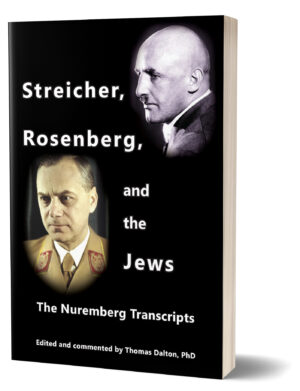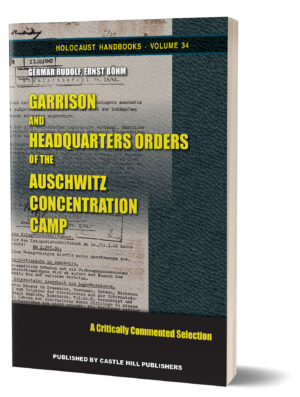Book Announcements
Streicher, Rosenberg, and the Jews
Authored by Thomas Dalton
 The Holocaust was certainly one of the most consequential events of the past 100 years. But the truth of that event is far different than commonly portrayed. Since the mid-1970s, it has come under sustained attack by a group of individuals known as Holocaust revisionists – to the point where, today, the story lies in ruins. Virtually every aspect of the standard account, we now realize, has serious and irreconcilable flaws. As a result, the actual Jewish death toll is far below the claimed figure of 6 million – likely in the range of half a million.
The Holocaust was certainly one of the most consequential events of the past 100 years. But the truth of that event is far different than commonly portrayed. Since the mid-1970s, it has come under sustained attack by a group of individuals known as Holocaust revisionists – to the point where, today, the story lies in ruins. Virtually every aspect of the standard account, we now realize, has serious and irreconcilable flaws. As a result, the actual Jewish death toll is far below the claimed figure of 6 million – likely in the range of half a million.
And yet, despite this intense and highly successful revisionist work, the orthodox version continues to dominate in the Western world. To fully understand this striking situation, we need to go back to the beginnings – to the origins of the conventional Holocaust story. And this takes us to Nuremberg.
Immediately after World War Two, the Allies initiated an extensive series of war-crimes trials against the Nazi hierarchy. The most famous of these occurred at Nuremberg, and the single most important trial was known as the International Military Tribunal, or IMT. Running for roughly one year, it tried 24 leading Nazis, including such major figures as Herman Göring and Martin Bormann. But the most interesting men on trial were two with a special connection to the “Jewish Question”: Alfred Rosenberg and Julius Streicher. The case against them, and their personal testimony, examined for the first time nearly all major aspects of the Holocaust story: the “extermination” thesis, the gas chambers, the gas vans, the shootings in the East, and the “6 million.”
The truth of the Holocaust has been badly distorted for decades by the powers that be. Here we have the rare opportunity to hear firsthand from two prominent figures in Nazi Germany. Their voices, and their verbatim transcripts from the IMT, lend some much-needed clarity to the situation.
Garrison and Headquarters Orders
of the Auschwitz Concentration Camp
Authored by Erich Böhm and Germar Rudolf
 A large number of all the orders ever issued by the various commanders of the infamous Auschwitz Camp have been preserved. They reveal the true nature of the camp with all its daily events.
A large number of all the orders ever issued by the various commanders of the infamous Auschwitz Camp have been preserved. They reveal the true nature of the camp with all its daily events.
In these orders, for example, the decent treatment of inmates, the prohibition of their mistreatment as well as the improvement of the hygienic conditions were emphasized. A topic discussed with particular frequency is the visit of family members of SS members to Auschwitz and their constant entering and exiting of the camp. Even the children of SS members were hanging around in the camp and were apparently playing with the inmates. There were even plenty of sightseeing tours of the camp during the war, which some orders tried to regulate. Horticulture, growing fruit trees, picking flowers and much more were addressed in these orders.
Only one thing is not to be found in these orders: the slightest trace of an indication that something outrageous was going on at Auschwitz. On the contrary, many orders are in clear and insurmountable contradiction to claims that inmates were being mass murdered. This book contains a selection of the most important of these orders, along with comments that put them in their proper historical context.
Miscellaneous Books
COVID-19 did not change much for me, as I had worked from home over the internet since 1996, but the concurrent, government-panic-induce economic crisis had our printer launch another Sonderaktion in April and May by waving all setup fees for new books or new editions. The result was again hyperactivity on my part of getting new books and revised edition out the door as quickly as possible:
German-Language Books
- Jürgen Graf, Auschwitz: Augenzeugenberichte und Tätergeständnisse des Holocaust (2nd edition)
- Carlo Mattogno: “Im Jenseits der Menschlichkeit” – und der Wirklichkeit (1st edition)
- Germar Rudolf (Hg.): Luftbild-Beweise (2nd edition)
- J. Graf: Der Holocaust: Die Argumente (5th edition)
- Germar Rudolf: Die Chemie von Auschwitz (4th edition)
- Warren Routledge, Elie Wiesel, Heiliger des Holocaust (1st edition)
- Nicholas Kollerstrom, Wie England beide Weltkriege einleitete (1st edition)
- Erich Böhm, Germar Rudolf, Standort- und Kommandanturbefehle des KL Auschwitz (1st edition)
- Castle Hill Publishers, Der Holocaust: Fakten versus Fiktion (1st edition, promotion brochure)
New Editions of English-Language Books
- Carlo Mattogno. Miklos Nyiszli: An Auschwitz Doctor’s Eyewitness Account (2nd edition)
- Carlo Mattogno, Thomas Kues, Jürgen Graf: Sobibór (2nd edition)
- Germar Rudolf (ed.): Air-Photo Evidence (6th edition)
- Germar Rudolf: The Chemistry of Auschwitz (4th edition)
- Carlo Mattogno, Jürgen Graf: Treblinka (3rd edition)
- Warren Routledge: Elie Wiesel, Saint of the Holocaust (3rd edition of what used to bear the title Holocaust High Priest: Elie Wiesel, “Night,” the Memory Cult, and the Rise of Revisionism)
Bibliographic information about this document: Inconvenient History, 2020, Vol. 12, No. 2
Other contributors to this document:
Editor’s comments:
